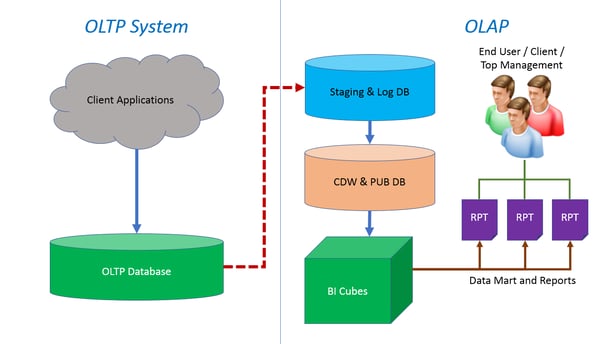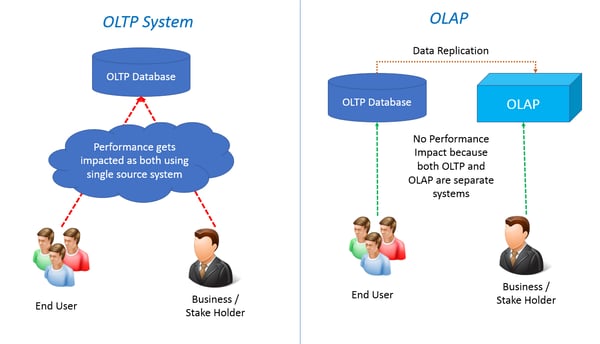
Organizations today are demanding quick access to more information for better decision making to improve efficiency and increase productivity resulting in reduced costs and improved revenue. This information must be secure, real-time, shared across different departments and presented in different ways to support the various needs of management.
What is Business Intelligence?
Business Intelligence (BI) is the process of extracting accumulated raw data through various software applications allowing a company to analyze and learn important information to help improve processes and performance. In today’s fast-paced digital world, this information is crucial to improve processes and workflows, better serve clients and to gain a competitive advantage.
Data is the key for success for any business. Data accumulates rapidly day by day and is always “raw.” For it to be useful information, data must be furbished, extracted, and converted in a strategic manner. In addition, it is important to extract accurate information from the data. Accuracy is key because the information must be trusted by management in order to make vital business decisions.
BI systems provide historical, current, and predictive views of business operations, most often using data that has been gathered into a data warehouse or a data mart and occasionally working from operational data. Applications tackle sales, production, financial, and many other sources of business data for purposes that include business performance management.
Acquiring good Business Intelligence takes time and effort – but the results can have long-term and lasting benefits.
Data Acquisition, Storage, and Processing
BI systems operate largely on data acquired automatically through a front-end "source" system, which could be a standalone application, web application, cloud-based portal, IT product, or mobile application.
The source system feeds real-time data into an OLTP (Online Transaction Processing) Database. Separately, the OLAP (Online Analytical Processing) Component is a computing method that enables users to easily and selectively extract and query data in order to analyze it from different points of view.
Since OLTP data keeps growing as more users access source systems, a separate system is ideally needed to perform the analytical operations of your data. It is not recommended to build the OLAP (Online Analytical Processing) systems on the top of a real-time database. Doing so increases the risk of degrading the performance of critical real-time applications.
ETL (Extract, Transform and Load) algorithms provide processes for data warehousing/replication and are responsible for pulling data out of the source systems and placing it into a data warehouse. ETL systems are utilized to migrate your OLTP data for analytical processing, which is the first step for converting data into useful information.
Usually, data migration happens during off business hours or when minimum user impact will occur. Incremental data load approaches are used to migrate the data from the OLTP system to OLAP processing.

Database Facts and Dimensions
Facts and dimensions in a database form the core of any business intelligence effort. These tables contain the basic data used to conduct detailed analyses and derive business value.
Dimensions are the core items in which calculations are made, such as, Country, State and City are territory-related dimensions; Name, Day, Month, Year and Time Zone are time-related dimensions. Similarly, there can be business specific dimensions, including Business Product, Client Segment, Sales Segment or Zones.
Facts are the calculations made against any dimension, so Total Sales, Total Customers, and Total Profit are considered facts.
A Business Intelligence System extrapolates your fact against one or multiple dimensions, such as, “Sales against Year”, “Customer against City.” The system also allows multiple dimensions to be used for calculations, such as “Yearly Sales against Country, State, City.” In this case, Year and State both are dimensions, so, you can compare yearly sales as well as by region.
Performance BI
Parallel and distributed processing platforms provide a higher computational and storage capacity. Companies must be able to ingest real-time streaming data from multiple sources and easily combine it with business process data. A combination of online transaction processing (OLTP) and online analytical processing (OLAP) is a must for managing the streaming data in real time
Reports can be built in real-time over OLTP system by calculating the data against any dimension. But this decreases the performance of the system because the user who is extracting data must wait until calculations are complete. These calculations impact the end user accessing the data negatively.
Providing a separate system for online analytical processing (OLAP) gives major advantages to your business. The measures are pre-calculated and stored in the cube, so any information can be quickly extracted at any time without impacting the real-time system.

Graphical Reporting and Dashboard
The BI system also supports graphical tools and graphical representation of the data. This helps management visually pinpoint trends and needs. For example, sales figures for the last 10 years can be represented with a bar diagram or as a growth line. You can represent a comparison report for sales over profit to identify overhead expenses. Similarly, data can be represented in any graphical format, such as, pie charts, bar graphs, histograms, comparisons, etc. Further, data can be integrated with dashboards tools that provide interactive click and drill-down features.
Enterprise Business Intelligence
Organizations are starting to see that data and content should not be considered separate aspects of information management, but instead should be managed in an integrated enterprise approach. Enterprise information management brings Business Intelligence and Enterprise Content Management together. Currently organizations are moving towards Operational Business Intelligence which is currently under served and uncontested by vendors. Traditionally, Business Intelligence vendors are targeting only top the pyramid but now there is a paradigm shift moving toward taking Business Intelligence to the bottom of the pyramid with a focus of self-service business intelligence.
Conclusion
Business Intelligence systems give extensive, multi-dimensional support for executives, business managers and other operational workers to make critical business decisions. Essentially, Business Intelligence systems are data-driven Decision Support Systems (DSS). To stay competitive and meet the ever-increasing demands of customers, businesses need information from across the entire enterprise to improve processes, performance, including supply chain, work force management, inventory levels, and much more. BI provides this information across all enterprise levels. By utilizing business intelligence, a company will improve visibility of their operations to better manage their business.
Tap in the industry's most complete software development and IT bench of experts. With delaPlex you have an arsenal of analytical, design and implementation skillsets to help with you with your Business Intelligence needs.

